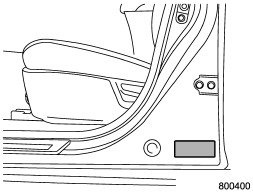GVWR and GAWR (Gross Vehicle Weight Rating and Gross Axle Weight Rating)

Certification label
The certification label attached to the driver’s side door shows GVWR (Gross Vehicle Weight Rating) and GAWR (Gross Axle Weight Rating).
The GVW (Gross Vehicle Weight) must never exceed the GVWR. GVW is the combined total of weight of the vehicle, fuel, driver, all passengers, luggage, any optional equipment and trailer tongue load. Therefore, the GVW changes depending on the situation.
In addition, the total weight applied to each axle (GAW) must never exceed the GAWR. The front and rear GAWs can be adjusted by relocating luggage inside the vehicle.
Even if the total weight of your luggage is lower than the vehicle capacity weight, either front or rear GAW may exceed the GAWR, depending on the distribution of the luggage.
When possible, the load should be evenly distributed throughout the vehicle. If you carry heavy loads in the vehicle, you should confirm that GVW and front and rear GAWs are within the GVWR and GAWR by putting your vehicle on a vehicle scale, found at a commercial weighing station.
Do not use replacement tires with a lower load range than the originals because they may lower the GVWR and GAWR limitations. Replacement tires with a higher load range than the originals do not increase the GVWR and GAWR limitations.
See also:
Parking on a grade
Always block the wheels under both vehicle and trailer when parking. Apply the
parking brake. You should not park on a hill or slope. But if parking on a hill
or slope cannot be avoided, you shoul ...
Parking in cold weather
WARNING
Snow can trap dangerous exhaust gases under your vehicle. Keep snow clear of
the exhaust pipe and from around your vehicle if you park the vehicle in snow with
the engine running.
Do not ...
Glossary of tire terminology
● Accessory weight
The combined weight (in excess of those standard items which may be replaced)
of automatic transmission, power steering, power brakes, power windows, power seats,
radio, ...


